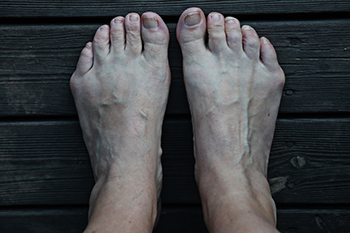
Tailor's bunion, also known as a bunionette, is a painful condition that develops on the outer side of the foot, specifically over the fifth metatarsophalangeal joint, or the 5th MPJ. This condition causes pressure pain, the formation of painful calluses, and difficulty when wearing shoes. One cause of tailor's bunion is a biomechanical abnormality where changes in your foot’s structure gradually cause the metatarsal bones to separate and a bunion to form. Conservative treatment options include padding, footwear modification, and custom-made orthotics. This condition is progressive and generally does not improve on its own. Surgical options include ostectomy, which removes the painful bump from the head of the fifth metatarsal. This type of surgery involves cutting the fifth metatarsal bone and realigning it. Surgical intervention may also include the removal of a painful bursa, if present. If tailor's bunion significantly hinders daily activities, causes discomfort while wearing shoes, or leads to excessive pain, it is suggested that you make an appointment with a podiatrist who can determine what the most appropriate course of action is.
If you are suffering from bunion pain, contact Deborah Rosenfeld of Rosenfeld Podiatry. Our doctor can provide the care you need to keep you pain-free and on your feet.
What Is a Bunion?
Bunions are painful bony bumps that usually develop on the inside of the foot at the joint of the big toe. As the deformity increases over time, it may become painful to walk and wear shoes. Women are more likely to exacerbate existing bunions since they often wear tight, narrow shoes that shift their toes together. Bunion pain can be relieved by wearing wider shoes with enough room for the toes.
Causes
- Genetics – some people inherit feet that are more prone to bunion development
- Inflammatory Conditions - rheumatoid arthritis and polio may cause bunion development
Symptoms
- Redness and inflammation
- Pain and tenderness
- Callus or corns on the bump
- Restricted motion in the big toe
In order to diagnose your bunion, your podiatrist may ask about your medical history, symptoms, and general health. Your doctor might also order an x-ray to take a closer look at your feet. Nonsurgical treatment options include orthotics, padding, icing, changes in footwear, and medication. If nonsurgical treatments don’t alleviate your bunion pain, surgery may be necessary.
If you have any questions, please feel free to contact our office located in Marlton, NJ . We offer the newest diagnostic and treatment technologies for all your foot care needs.

